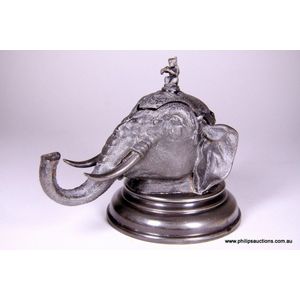Mappin & Webb Elephant Head Inkwell
You must be a subscriber, and be logged in to view price and dealer details.
Subscribe Now to view actual auction price for this item
When you subscribe, you have the option of setting the currency in which to display prices to $Au, $US, $NZ or Stg.
- Epbm / Britannia Metal - Britannia metal is a pewter type alloy, that can be temporarily polished to a silver-like lustre. In the 19th century, Britannia metal, was often electroplated. Plated wares in this metal may be marked EPBM (electro-plated Britannia metal). Where the silver plate wears on an EPBM item, the surface colour is dull grey, similar to pewter. Britannia metal was generally used as a cheaper alternative to electroplated nickel silver (EPNS) which is more durable. The primary component of nickel silver is copper and wear on an EPNS item will be indicated by a copper colored hue in the wear spots. EPBM items are held in low regard by collectors.
- Victorian Period - The Victorian period of furniture and decorative arts design covers the reign of Queen Victoria from 1837 to 1901. There was not one dominant style of furniture in the Victorian period. Designers used and modified many historical styles such as Gothic, Tudor, Elizabethan, English Rococo, Neoclassical and others, although use of some styles, such as English Rococo and Gothic tended to dominate the furniture manufacture of the period.
The Victorian period was preceded by the Regency and William IV periods, and followed by the Edwardian period, named for Edward VII (1841 ? 1910) who was King of the United Kingdom and the British Dominions and Emperor of India for the brief period from 1901 until his death in 1910. - Britannia Metal / Epbm - Britannia metal items, often marked as "EPBM", are composed of a pewter type alloy of tin animony and copper, First produced in 1769, Britannia metal can be temporarily polished to a silver-like lustre. When electroplate was introduced in the mid 19th century, the Britannia newly manufactured Britannia metal items were oftern silver plated, but the plating wears off relatively quickly leaving an unappealing grey surface.
Britannia metal should not to be confused with Britannia standard silver, which is a higher grade of silver than sterling silver, containing at least 958 parts per thousand of pure silver, - Finial - An architectural decoration, found on the upper parts of of an object. On furniture they are usually found on pediments, canopies and shelf supports. On smaller ceramic or silver items, such as spoons, they may decorate the top of the item itself, or the lid or cover where they provide a useful handle for removal.
Finials have a variety of shapes and forms. They may be urn-shaped, baluster shaped round or spiral, but usually taper into an upper point. Many real life shapes may also be used as finials, such as pineapples, berries, pinecones, buds, lotus and acorns. Sometimes animals such as a lion are depicted, or fish and dolphins.
This item has been included into following indexes:
-
ink wells / ink stands, material
- porcelain, pottery 70
- silver items 303
- silver plate items 84
- ink wells / ink stands, period or age - Victorian 86
Visually similar items

A French Art Noveau gilded silver mounted claret jug, Paris, circa 1890, possibly Baccarat and Roussel Eugene Doutre, the frosted glass carved in low relief with flowering braches picket out in gilt, unmarked, 33 cm high

A German sterling silver four piece tea and coffee service on an oval two handled tray, early 20th century decorated with swirled embossed floral panels, flower finials, the coffee pot 26 cm high, the tray 58 x 36 cm, 4,400 grams

A sterling silver three handled vase. 9.5 cm high.

A George IV large and impressive Irish silver coffee pot, profuse decorative relief embossing of an exotic bird holding cherries to its mouth, florals and C-scrolls, engraved armorial within a cartouche to one side, a vacant cartouche the other, conforming
